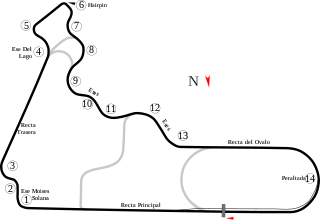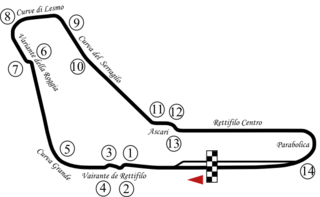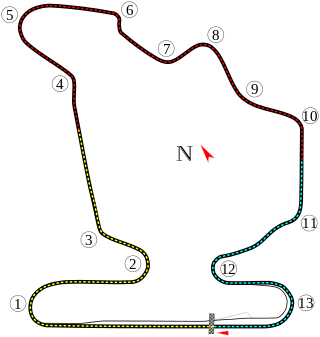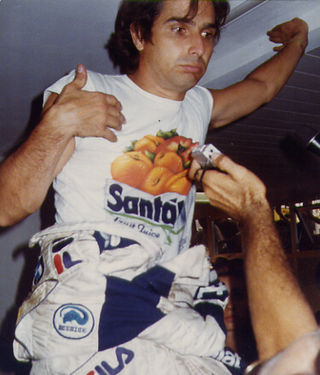
The 1988 Brazilian Grand Prix was a Formula One motor race held on 3 April 1988, at the renamed Autódromo Internacional Nelson Piquet in Rio de Janeiro. Following his 3rd World Drivers' Championship in 1987 the Jacarepaguá Circuit was named after local hero Nelson Piquet. It was the first race of the 1988 Formula One season.

The 1988 Monaco Grand Prix was a Formula One motor race held on 15 May 1988 at the Circuit de Monaco, Monte Carlo. It was the third race of the 1988 Formula One World Championship.

The 1988 Mexican Grand Prix was a Formula One motor race held on 29 May 1988 at the Autódromo Hermanos Rodríguez, Mexico City. It was the fourth race of the 1988 Formula One World Championship. The 67-lap race was won by Alain Prost, driving a McLaren-Honda, with teammate Ayrton Senna second and Gerhard Berger third in a Ferrari.
The 1988 Canadian Grand Prix was a Formula One motor race held on 12 June 1988 at the Circuit Gilles Villeneuve, Montreal. It was the fifth race of the 1988 Formula One World Championship. The 69-lap race was won from pole position by Brazilian driver Ayrton Senna, driving a McLaren-Honda, with French teammate Alain Prost second and Belgian Thierry Boutsen third in a Benetton-Ford.

The 1988 French Grand Prix was a Formula One motor race held on 3 July 1988 at the Circuit Paul Ricard, Le Castellet. It was the seventh race of the 1988 Formula One World Championship.

The 1988 British Grand Prix was a Formula One motor race held on 10 July 1988 at the Silverstone Circuit, Silverstone. It was the eighth race of the 1988 FIA Formula One World Championship.

The 1988 German Grand Prix was a Formula One motor race held on 24 July 1988 at the Hockenheimring, Hockenheim. It was the ninth race of the 1988 Formula One World Championship.

The 1988 Belgian Grand Prix was a Formula One motor race held at the Circuit de Spa-Francorchamps on 28 August 1988. It was the eleventh race of the 1988 Formula One World Championship.

The 1988 Italian Grand Prix was a Formula One motor race held on 11 September 1988 at the Autodromo Nazionale di Monza, Monza. It was the twelfth race of the 1988 season. It is often remembered for the first win and 1–2 finish for the Ferrari team after the death of team founder Enzo Ferrari, and as the only race of the 1988 season that was not won by McLaren-Honda. It is also the only Grand Prix in the 1988 season without a McLaren-Honda driver on the podium, as well as Ferrari's last win at Monza until 1996.

The 1988 Portuguese Grand Prix was a Formula One motor race held on 25 September 1988 at the Autódromo do Estoril, Estoril. It was the thirteenth race of the 1988 Formula One World Championship. The 71-lap race was won by Alain Prost, driving a McLaren-Honda, with Ivan Capelli second in a March-Judd and Thierry Boutsen third in a Benetton-Ford. Prost's teammate and Drivers' Championship rival, Ayrton Senna, could only manage sixth.

The 1988 Spanish Grand Prix was a Formula One motor race held on 2 October 1988 at the Circuito Permanente de Jerez, Jerez de la Frontera. It was the fourteenth race of the 1988 Formula One World Championship.

The 1988 Australian Grand Prix was a Formula One motor race held at the Adelaide Street Circuit on 13 November 1988. It was the sixteenth and final race of the 1988 Formula One World Championship, and the last race for which turbocharged engines would be eligible until the 2014 Australian Grand Prix.

The 1989 Australian Grand Prix was a Formula One motor race held at Adelaide on 5 November 1989. It was the sixteenth and final race of the 1989 Formula One World Championship.

The 1990 German Grand Prix was a Formula One motor race held at the Hockenheimring on 29 July 1990. It was the ninth race of the 1990 Formula One World Championship. The race was the 52nd German Grand Prix and the 14th to be held at the Hockenheimring. It was the 39th and last Formula One Grand Prix to be held in West Germany prior to its re-unification with East Germany. The race was held over 45 laps of the seven kilometre circuit for a race distance of 306 kilometres.

The 1990 Hungarian Grand Prix was a Formula One motor race held at Hungaroring on 12 August 1990. It was the tenth race of the 1990 Formula One World Championship. The race was the sixth Hungarian Grand Prix and the fifth to be held at the Hungaroring. It was held over 77 laps of the 3.97-kilometre (2.47 mi) circuit for a race distance of 305.5 kilometres (189.8 mi).

The 1990 FIA Formula One World Championship was the 44th season of FIA Formula One motor racing. It featured the 1990 Formula One World Championship for Drivers and the 1990 Formula One World Championship for Constructors, which were contested concurrently over a sixteen-race series that commenced on 11 March and ended on 4 November. Ayrton Senna won the Drivers' Championship for the second time, and McLaren-Honda won their third consecutive Constructors' Championship.

The 1989 FIA Formula One World Championship was the 43rd season of FIA Formula One motor racing. It began on 26 March and ended on 5 November. Alain Prost won his third Drivers' Championship, and McLaren won the Constructors' Championship.

The 1988 FIA Formula One World Championship was the 42nd season of FIA Formula One motor racing. It featured the 1988 Formula One World Championship for Drivers and the 1988 Formula One World Championship for Constructors, which were contested concurrently over a sixteen-race series that commenced on 3 April and ended on 13 November. The World Championship for Drivers was won by Ayrton Senna, and the World Championship for Constructors by McLaren-Honda. Senna and McLaren teammate Alain Prost won fifteen of the sixteen races between them; the only race neither driver won was the Italian Grand Prix, where Ferrari's Gerhard Berger took an emotional victory four weeks after the death of team founder Enzo Ferrari. McLaren's win tally has only been bettered or equalled in seasons with more than sixteen races; their Constructors' Championship tally of 199 points, more than three times that of any other constructor, was also a record until 2002.

The 1987 FIA Formula One World Championship was the 41st season of FIA Formula One motor racing. It featured the 1987 Formula One World Championship for Drivers and the 1987 Formula One World Championship for Constructors, which were contested concurrently over a sixteen-race series that commenced on 12 April and ended on 15 November.

The 1986 FIA Formula One World Championship was the 40th season of FIA Formula One motor racing. It featured the 1986 Formula One World Championship for Drivers and the 1986 Formula One World Championship for Manufacturers, both of which commenced on 23 March and ended on 26 October after sixteen races. The Drivers' Championship was won by Alain Prost, Prost was the first driver to win back-to-back Drivers' Championships since Jack Brabham in 1959 and 1960. Together with Prost, Nigel Mansell, Nelson Piquet and Ayrton Senna dominated throughout the season and formed what was dubbed as the "Gang of Four".


















